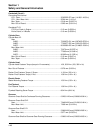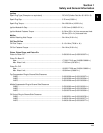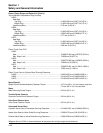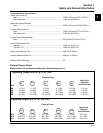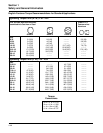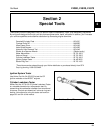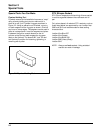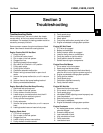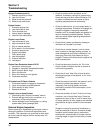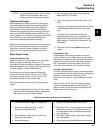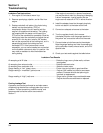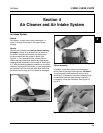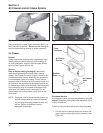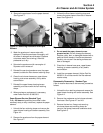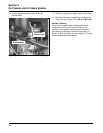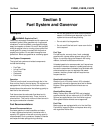
3.2
Section 3
Troubleshooting
Engine Overheats (cont'd.)
7. Radiator cap faulty or loose.
8. Lean fuel mixture.
9. Water pump belt failed/off.
10. Water pump malfunction.
Engine Knocks
1. Excessive engine load.
2. Low crankcase oil level.
3. Old or improper fuel.
4. Internal wear or damage.
5. Hydraulic lifter malfunction.
Engine Loses Power
1. Low crankcase oil level.
2. High crankcase oil level.
3. Dirty air cleaner element.
4. Dirt or water in the fuel system.
5. Excessive engine load.
6. Engine overheated.
7. Faulty spark plugs.
8. Low compression
9. Exhaust restriction.
10. Low battery.
Engine Uses Excessive Amount Of Oil
1. Incorrect oil viscosity/type.
2. Clogged or improperly assembled breather.
3. Worn or broken piston rings.
4. Worn cylinder bore.
5. Worn valve stems or valve guides.
6. Crankcase overfilled.
Oil Leaks from Oil Seals, Gaskets
1. Crankcase breather is clogged or inoperative.
2. Loose or improperly torqued fasteners.
3. Piston blowby or leaky valves.
4. Restricted exhaust.
Engine Loses or Uses Coolant
1. Overheating-See ‘‘Engine Overheats’’ section.
2. External leakage-from a joint connection, or a
component of the cooling system.
3. Internal leakage-from a head gasket, or cooling
system water jacket (passage) leak.
External Engine Inspection
Before cleaning or disassembling the engine, make a
thorough inspection of its external appearance and
condition. This inspection can give clues to what might
be found inside the engine (and the cause) when it is
disassembled.
• Check for buildup of dirt and debris on the
radiators, crankcase, cooling fins, grass screen,
blower housing and other external surfaces. Dirt
or debris on these areas are causes of higher
operating temperatures and overheating.
• Check for obvious fuel, oil, and coolant leaks, or
damaged components. Excessive oil leakage can
indicate a clogged or improperly assembled
breather, worn or damaged seals and gaskets, or
loose or improperly torqued fasteners. Coolant
leaks can cause higher operating temperatures
and overheating.
• Check the air cleaner and base for damage or
indications of improper fit and seal.
• Check the air cleaner element. Look for holes,
tears, cracked or damaged sealing surfaces, or
other damage that could allow unfiltered air into
the engine. Also note if the element is dirty or
clogged. These could indicate that the engine has
been underserviced.
• Check the carburetor throat for dirt. Dirt in the
throat is further indication that the air cleaner is
not functioning properly.
• Check the oil level. Note if the oil level is within
the operating range on the dipstick, or if it is low
or overfilled.
• Check the coolant level within the reservoir and in
the neck of radiator cap adapter. A low or
improperly filled cooling system can cause
overheating, excessive fuel consumption, and a
lack of power.
• Check the condition of the oil. Drain the oil into a
container - the oil should flow freely. Check the
appearance (color) of the oil, and for metal chips
or foreign particles. A milky, opaque color denotes
the presence of engine coolant in the crankcase
oil.
Sludge is a natural by-product of combustion; a
small accumulation is normal. Excessive sludge
formation could indicate overrich carburetion,
weak ignition, overextended oil change intervals
or wrong weight or type of oil was used, to name
a few.



